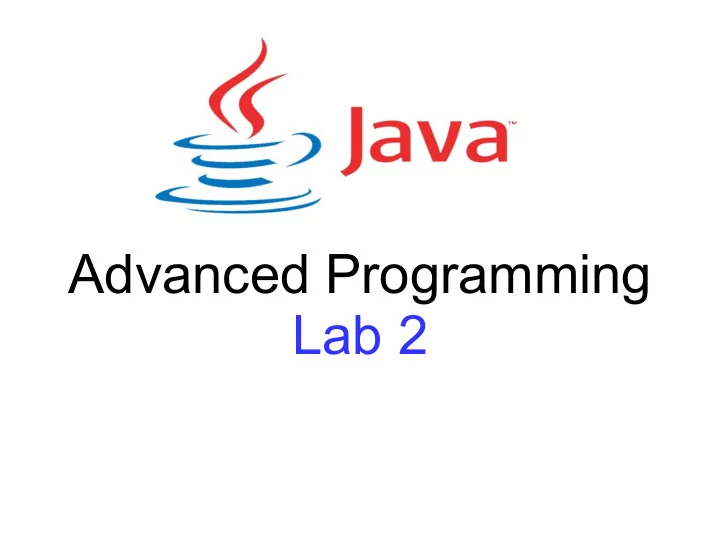

Advanced Programming Lab 2
Object-Oriented Programming ● Read the definition of the problem (expressed in natural language) ● Identify the candidates for the classes . “An instance of MDVSP consists of depots , vehicles and clients (trips).” ● Determine the relationship between classes ● Define the class members : – constructors, variables, methods – properties ● Draw the UML class diagram
The Client Class public class Client { private String name ; Refactor → Encapsulate fields Refactor → Encapsulate fields private int order ; (Generate getter / setter) (Generate getter / setter) public Client() { } public Client(String name, int order) { this.name = name; this.order = order; } Why not make everything public? // … getters and setters public String toString() { return name; } }
Using the Client Class public class Main { public static void main(String args[]) { Client c1 = new Client(); c1.setName("Client 1"); c1.setOrder(1); System.out.println(c1.getName()); Client c2 = new Client("Client 2", 1); System.out.println(c2); System.out.println( new Client("Client 3") ); } //where is the bug }
The Vehicle Class public class Vehicle { private String name ; private Depot depot; private VehicleType type; public Vehicle(String name) { this.name = name; } // … getters and setters The method setDepot should not // … toString be public. Why? @Override public boolean equals(Object obj) { if (obj == null || !(obj instanceof Vehicle)) { return false; } Vehicle other = (Vehicle) obj; return name.equals(other.name); } }
The Depot Class public class Depot { private String name ; private Vehicle[] vehicles; // … constructor(s) // … getter and setter for name public void setVehicles(Vehicle ... vehicles) { this.vehicles = vehicles; for(Vehicles v : vehicles) { Variable number of arguments v.setDepot(this); Depot d1 = new Depot("Depot 1"); } d1.setVehicles(v1, v2); } Depot d2 = new Depot("Depot 2"); // … getVehicles d2.setVehicles(v3); // … toString // … equals }
The Tour, Problem, Main Classes public class Problem { private Depot[] depots; private Client[] clients; … } public class Tour { private Vehicle vehicle; private Client[] clients; … } public class Main { public static void main(String args[]) { Problem pb = new Problem(); //...create vehicles, clients, depots System.out.println(pb); } }
Evolving the Model public abstract class Vehicle { protected String name; … } public class Car extends Vehicle { … } public class Truck extends Vehicle { … } Vehicle[] vehicles = new Vehicle[2]; vehicles[0]= new Car(); vehicles[1]= new Truck();
The Algorithms ● A greedy allocation of trips to vehicles is ok for the optional part. Some vehicles may remain unused, some trips may remain uncovered. ● For the bonus , observe that the cost matrix represents the adjacency matrix of a directed acyclic graph (dag) . Implement the algorithm for determining a shortest path in a dag (or Dijkstra).
The Research Project ● Vehicle Routing Problems (VRS) ● Vehicle Scheduling Problems (VSP) ● Both have many variants (multi depot, time windows, preferences, online, etc) ● Many applications in public transportation ● Approached with flows , circulations , integer linear programming ( ILP ), evolutionary algorithms (genetic, ant-colony, etc), various heuristics.
Recommend
More recommend